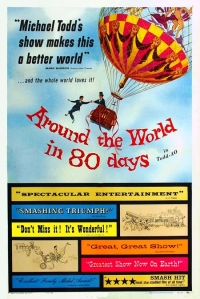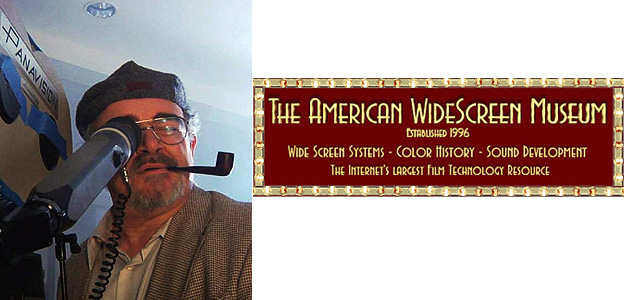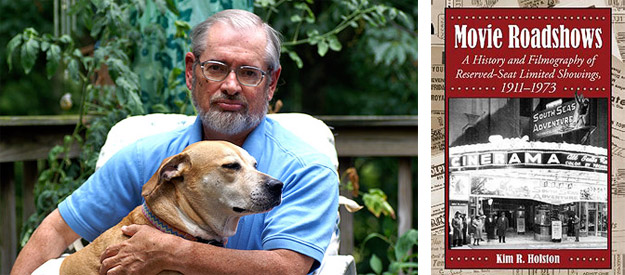“Around the World in Eighty Days, and more specifically, Mike Todd, defined the way to sell a hard ticket roadshow film. It was important to present the show just like the legitimate stage on Broadway.” — American Widescreen Museum curator Martin Hart
The Digital Bits and History, Legacy & Showmanship are pleased to present this retrospective article commemorating the 60th anniversary of the release of Around the World in Eighty Days, Mike Todd’s cinematic production of the classic Jules Verne novel which starred David Niven, Cantinflas and Shirley MacLaine, plus an all-star selection of cameos. [Read on here...]
For the occasion The Bits features a compilation of box-office data and trivia for the movie which places its theatrical performance in context, a reference/historical listing of the movie’s Todd-AO roadshow presentations, and an interview segment with a group of film historians.
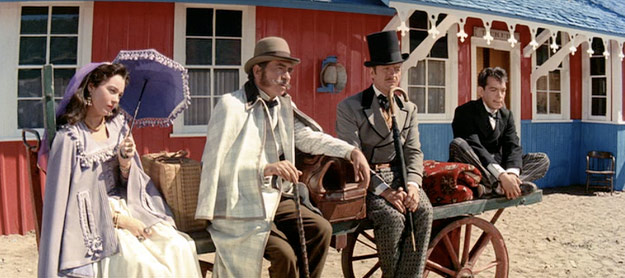
EIGHTY DAYS NUMBER$
- 1 = Number of opening-week bookings
- 2 = Rank among top-earning films of 1956 (legacy)
- 3 = Rank on all-time list of top-earning films at close of original run / peak chart position
- 5 = Number of Academy Awards
- 8 = Number of Academy Award nominations
- 9 = Number of years United Artists’ most-successful film
- 48 = Number of 70mm prints
- 49 = Rank on current list of all-time top-grossing films (adjusted for inflation)
- 127 = Number of days it took to shoot the movie
- 127 = Number of weeks longest-running engagement played
- 1,569 = Number of first-run roadshow bookings, 1956-58
- $6.0 million = Production cost
- $22.0 million = Box-office rental (as of January 1, 1960)
- $23.0 million = Box-office rental (as of January 1, 1969)
- $23.1 million = Box-office rental (as of January 1, 1985)
- $42.0 million = Box-office gross
- $53.1 million = Production cost (adjusted for inflation)
- $556.3 million = Box-office gross (adjusted for inflation)
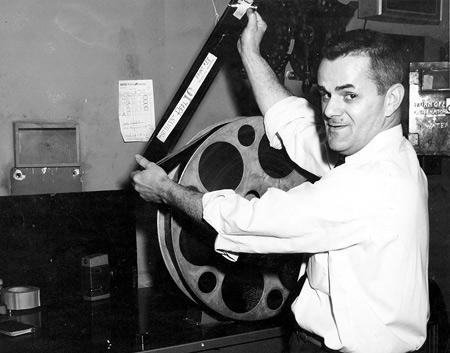
THE TODD-AO ROADSHOW ENGAGEMENTS
Presented here is a chronological listing of the “hard ticket” roadshow engagements in the United States and Canada of Around the World in Eighty Days that were presented in 70-millimeter and six-track stereophonic sound at the original Todd-AO projector speed of 30 frames per second. These were special, long-running, showcase presentations in major cities prior to the film being exhibited as a general release, and they featured advanced admission pricing, reserved seating, an overture/intermission/entr’acte/exit music, and with an average of ten scheduled screenings per week. Souvenir program booklet were sold, as well. (Beginning in late-Spring 1957, 35mm prints — at 24 frames per second — began circulating for most of the film’s roadshow bookings.)
Out of hundreds of films released during 1956, Eighty Days was among only four that were given deluxe roadshow treatment.
The film’s anniversary offers an opportunity to namedrop some famous and once-glorious cinemas, to provide some nostalgia for those who saw the film during this phase of its original release, and to reflect on how the film industry has evolved the manner in which event and prestige films are exhibited.
The film’s 70mm prints were intended to be projected in a 2.21:1 aspect ratio and the soundtrack featured five discrete screen channels plus one discrete (and possibly Perspecta-encoded) surround channel.
The listing does not include the film’s roadshow engagements that were presented in 35mm, nor does it include any of the subsequent general release, second run, international, and re-release engagements. The duration of the engagements, measured in weeks, has been included after each cinema name in parenthesis for most of the entries to provide some measure of the film’s success.
So, which North American theaters screened the Todd-AO 30fps version of Around the World in Eighty Days?

- 1956-10-17 … New York, NY — Rivoli (103 weeks)
- 1956-12-19 … Houston, TX — Tower (40)
- 1956-12-20 … Dallas, TX — Tower (46)
- 1956-12-21 … Baltimore, MD — Film Centre (54)
- 1956-12-21 … Miami (Miami Beach), FL — Sheridan (66)
- 1956-12-22 … Los Angeles, CA — Carthay Circle (127)
- 1956-12-26 … San Francisco, CA — Coronet (95)
- 1956-12-27 … Detroit, MI — United Artists (67)
- 1956-12-27 … Philadelphia, PA — Midtown (53)
- 1957-01-10 … San Antonio, TX — Broadway (34)
 1957-01-23 … New Orleans, LA — Panorama (28)
1957-01-23 … New Orleans, LA — Panorama (28)
- 1957-03-01 … Montreal, QC — Alouette (44)
- 1957-04-04 … Chicago, IL — Cinestage (90)
- 1957-04-05 … Buffalo, NY — Century (22)
- 1957-04-08 … Washington, DC — Uptown (51)
- 1957-04-11 … Pittsburgh, PA — Nixon (38)
- 1957-04-17 … Oklahoma City, OK — State (17)
- 1957-04-17 … Portland, OR — Broadway (36)
- 1957-04-17 … Seattle, WA — Blue Mouse (50)
- 1957-04-17 … Tulsa, OK — Rialto (17)
- 1957-04-20 … Boston, MA — Saxon (50)
- 1957-05-15 … Corpus Christi, TX — Tower (9)
- 1957-05-15 … Denver, CO — Tabor (36)
- 1957-05-15 … Little Rock, AR — Capitol (9)
- 1957-05-28 … Atlantic City, NJ — Virginia
- 1957-05-28 … Louisville, KY — Brown (18)
- 1957-05-29 … Kansas City, MO — Tower (27)
- 1957-05-29 … Syracuse (DeWitt), NY — Shoppingtown (35)
- 1957-06-12 … Milwaukee, WI — Strand (49)
- 1957-06-13 … Cincinnati, OH — Valley (35)
- 1957-06-14 … Cleveland, OH — Ohio (42)
- 1957-06-26 … Atlanta, GA — Roxy (30)
- 1957-07-12 … Minneapolis, MN — Academy (49)
- 1957-07-24 … Rochester, NY — Monroe (30)
- 1957-07-30 … Hartford, CT — Strand (15)
- 1957-08-01 … San Diego, CA — Capri (45)
- 1957-08-07 … Toronto, ON — Tivoli (48)
- 1957-08-08 … Fort Wayne, IN — Clyde (12)
- 1957-08-08 … Indianapolis, IN — Lyric (26)
- 1957-08-14 … Jacksonville, FL — 5 Points (12)
- 1957-08-22 … Beaumont, TX — Liberty (8)
- 1957-09-12 … Columbus, OH — Cinestage (37)
- 1957-10-03 … Buffalo, NY — Granada (20)
- 1957-10-10 … Providence, RI — Elmwood (29)
- 1957-10-16 … Youngstown, OH — State (12)
- 1957-10-17 … Shreveport, LA — Saenger (12)
- 1957-12-19 … Phoenix, AZ — Vista (11)
- 1958-07-16 … Oyster Bay (Syosset), NY — Syosset (15)

THE Q&A
Sheldon Hall is the author (with Steve Neale) of Epics, Spectacles, and Blockbusters: A Hollywood History (Wayne State University Press, 2010). He is a Senior Lecturer in film studies at Sheffield Hallam University, UK. Other books of his include Zulu: With Some Guts Behind It—The Making of the Epic Movie (Tomahawk Press, 2005; updated in 2014) and (with John Belton and Steve Neale) Widescreen Worldwide (Indiana University Press, 2010).
Martin Hart is the curator of the American Widescreen Museum.
Kim Holston is the author of Movie Roadshows: A History and Filmography of Reserved-Seat Limited Showings, 1911-1973 (McFarland, 2013). Kim is a part-time librarian in the Multimedia Department of Chester County Library (Exton, PA) and lives in Wilmington, DE, with his wife Nancy and a menagerie of pets. He is the author of various film and performing arts books, including Starlet (McFarland, 1988), Richard Widmark: A Bio-Bibliography (Greenwood Press, 1990), Susan Hayward: Her Films and Life (McFarland, 2002), and (with Warren Hope) The Shakespeare Controversy (McFarland, 2nd ed., 2009), and recently Attila’s Sorceress (New Libri Press, 2014) and Naval Gazing: How Revealed Bellybuttons of the 1960s Signaled the End of Movie Cliches Involving Negligees, Men’s Hats and Freshwater Swim Scenes (BearManor Media, 2014). He is presently at work with Tom Winchester on a follow-up to their 1997 book, Science Fiction, Fantasy and Horror Film Sequels, Series and Remakes.
The interviews were conducted separately and have been edited into a “roundtable” conversation format.
---
Michael Coate (The Digital Bits): We’ve come upon the 60th anniversary of the release of Mike Todd’s production of Around the World in Eighty Days. In what way should the film be remembered?
Sheldon Hall: It’s one of those Oscar-winners that regularly appears on lists of films that don’t deserve to have been named Best Picture; that seems largely to be how it is remembered nowadays. But it’s a better movie than its current reputation suggests, with the simple bad luck to be unfashionable and lacking in a name director (though Michael Anderson was responsible for a number of other well-liked films and is of course happily still with us). It’s a well-crafted, entertaining film that tells us a lot about the popular taste of the time, as well as being a minor milestone technically and commercially.
Martin Hart: I think Around the World in Eighty Days should be viewed just as you would any other picture, but a knowledge of cinema history helps the viewer form an opinion. For some people it can be classified as a big boring movie filled with lots of actors we don’t know playing lots of bit parts; for others it can be seen as high adventure that works its way from London to New York with the aid of dozens of top stars of the forties and early fifties…. There are very few people still alive that were able to see it in a real Todd-AO equipped theater. Most people will have seen it only on television with its poorly panned and scanned crummy NTSC color and high fidelity mono sound. That was my first exposure to it and I was terribly disappointed. My parents had seen it in 1958 in a drive-in near St. Paul, Minnesota, and had told me that it was just dreadful. That’s why I was surprised at how awful it was when I saw it on TV; my folks didn’t know quality from day old popcorn so I was expecting it to be much better…. Fortunately Warner Home Video assembled a pretty decent looking and sounding DVD from the 35mm version negative. People have complained about the transfer not having been made from the 30fps Roadshow negative and knowing the folks at Warner Home Video I think we can take their word for it that the time and cost required to make it beautiful was way out of line with any possible return. For me, I found the complete picture to be far better than many roadshow films produced during the following decades.
Kim Holston: Along with that year’s The Ten Commandments and War and Peace, it heralded the golden age of roadshows that would ramp up dramatically by the end of the decade.
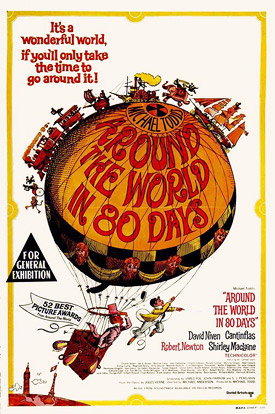 Coate: Can you describe what it was like seeing Eighty Days for the first time?
Coate: Can you describe what it was like seeing Eighty Days for the first time?
Hall: I saw it for the first time on Good Friday, 1975 — its first showing on BBC television (though it had previously been shown by the UK commercial network ITV). I was ten years old and enjoyed it enormously (note: in order to see Eighty Days I had to miss the UK TV premiere of The Robe on the rival channel). It was more than two decades later before I saw it for the first time in a cinema and I have now seen it several times in 70mm, on both a curved and a flat screen.
Hart: I first saw it on my cheesy 19” black-and-white set with typical TV sound. Not too impressed. I caught it a few years later and I had a color TV by then but there wasn’t much good that could be said about the color of that pan and scan transfer. I just knew the movie had to be better than what I’d seen thus far. Finally, many years later I had built a home theater with huge screen and about a dozen and a half speakers and that’s when I bought the DVD. In that environment and with the vastly improved picture and sound I finally felt like I had some understanding why audiences raved about the “show.” (That’s Mike Todd Speak for moom pitchers.)
Holston: I saw it during its major re-release in 1968 at the new Theatre 1812 in Philadelphia. I liked it but it didn’t knock my socks off. This might have been caused by anticipating seeing an Academy Award winner that was epic in scope and had a music score by one of the masters, Victor Young. I’d been playing the soundtrack for years.
Coate: How is Eighty Days significant among spectacles?
Hall: It was one of the first blockbuster comedies and one of the first films with a truly all-star cast: as other contributors may well point out, Mike Todd adopted the word “cameo” to describe the fleeting guest appearance of a well-known personality.
Holston: It covered the globe and was not Biblical, based on historical fact, or a flat-out travelogue.
Coate: In what way was it beneficial for Eighty Days to have been released as a roadshow?
Hall: Todd rightly understood that the film needed to be sold as a special attraction: not just a movie but a “show.” Roadshow presentation created the sense of occasion that he wanted and took the film out of the normal run of cinema. Given its high cost, large scale and three-hour length, any other form of presentation would have been counter-productive — though some other very long films released the same year were not presented as roadshows in the U.S. (Giant, War and Peace). Conversely, I don’t think Eighty Days was ever given a regular general release in the UK.
Hart: Around the World in Eighty Days, and more specifically, Mike Todd, defined the way to sell a hard ticket roadshow film. It was Todd that convinced Cinerama to go the hard ticket route and the company continued to do so for approximately 15 years. When you bought your ticket for seats 1-4 in row 15 you knew you had a reserved place to sit and you knew that dumbass that lived next door wasn’t going to be able to see it for a while. For Mike Todd it was important to present the show just like the legitimate stage on Broadway. Indeed, 70mm came to be the predominant roadshow method of presentation. There were exceptions but they were rare.
Holston: It had the scope. Theaters had to spend lots of money to upgrade their screens and sound to present it properly, but they usually did, and it paid off. Subconsciously at least, roadshows were viewed as something akin to the opera or ballet, a special event or night out.
Coate: Around the World in Eighty Days was among only a handful of films produced in Todd-AO. In what way was using that process beneficial?
Hall: It makes more extensive use of the wide-angle lens than did the first film in the process, Oklahoma!, and obviously has a much wider range of locales that could be exploited for their scenic and spatial possibilities. The “bug-eye” lens is most effectively used in the London sequences, such as in Passepartout’s cycle ride through the streets.
Hart: Strictly speaking there were only two features produced in the original Todd-AO format with its wide wall-to-wall, ceiling-to-floor curved screen [and 30 frames-per-second frame rate]. Those were Oklahoma! and Around the World in Eighty Days. [Then] it was decided to drop the frame rate to 24fps like other films. Starting with South Pacific (1958) all other Todd-AO productions were made at 24fps and most theaters used flat screens. The original Todd-AO process kicked off the large negative roadshow but the deeply curved screen did not survive other than in the unsatisfying 70mm Cinerama process.
Holston: The publicity for this new process helped entice audiences away from the small screen.
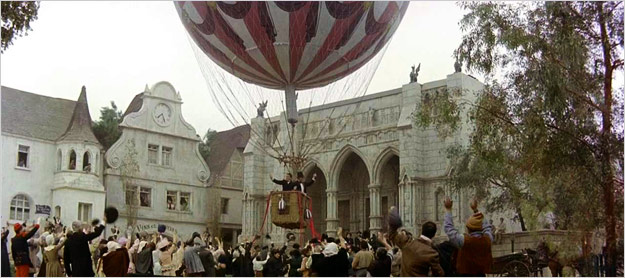
Coate: Todd’s Around the World in Eighty Days was shot twice. Why?
Hall: The film was shot twice to allow a print-down 35mm version to be shown at the regular speed of 24 frames per second (fps) rather than the 30 fps of Todd-AO. But a 30-fps 35mm version was also made available in an anamorphic process Todd named Cinestage, so there was considerable room for flexibility!

Coate: Should both versions of the film be made available for the various ancillary markets?
Hall: Although it would be useful for scholars to have both versions available for comparison, the differences between them would most likely be too minimal to justify releasing both on a special edition Blu-ray.
Coate: Can you compare and contrast Todd’s Eighty Days with the original novel and numerous film and TV adaptations?
Hall: I’ve not read the novel and the only other adaptation I’ve seen (aside from the children’s animated series that used to appear on television in the 1970s) is the 2004 version starring Jackie Chan and Steve Coogan, which is simply dreadful.
Hart: Neither Mike Todd’s nor any other film or television producers have paid a lot of attention to the Verne novel. That doesn’t bother me in the least.
Holston: It remains the biggest and most star-studded cinematic version.
Coate: Where do you think Eighty Days ranks among producer Mike Todd’s body of work?
Hall: Todd’s body of work in the cinema is not very great. His involvement in Oklahoma! and before that Cinerama was somewhat peripheral, and I can’t comment on his non-film work. Eighty Days is really the only thing for which he’s remembered, aside from marrying Elizabeth Taylor and dying in a plane crash, neither of which was unique.
Hart: Since Mike Todd’s body of work includes just one film, which was an unbelievable money maker, and a bunch of Broadway musicals of varying quality it’s hard to say anything other than Eighty Days was at the top.
Holston: The apotheosis.
 Coate: Michael Todd’s involvement as producer seems to have overshadowed Michael Anderson’s contribution as director. What do you think Anderson brought to the project, and where do you think the film ranks among director Michael Anderson’s body of work?
Coate: Michael Todd’s involvement as producer seems to have overshadowed Michael Anderson’s contribution as director. What do you think Anderson brought to the project, and where do you think the film ranks among director Michael Anderson’s body of work?
Hall: Michael Anderson was an unusual choice of director because, at the age of 36 and with only a half-dozen, mostly low-budget feature films under his belt, he was relatively young and inexperienced for such a large-scale, expensive project as Eighty Days. Anderson had also only worked in Britain, not America; but it was perhaps this very freshness that appealed to Todd as a Hollywood outsider himself. Or perhaps it might have seemed to make the director more malleable and susceptible to the producer’s influence? In any event, Anderson had demonstrated his ability to handle complex logistics with his immediately preceding film The Dam Busters, a huge box-office hit in the UK, so perhaps that also gave him the commercial pedigree for the Todd job…. For me, The Dam Busters, Operation Crossbow and Eighty Days are (in that order) Anderson’s best film work, though I must admit to not having seen some of his early features (including a second 1956 release, the film adaptation of the TV play of George Orwell’s 1984, which sounds particularly intriguing).
Coate: What is the legacy of Around the World in Eighty Days?
Hall: It gave rise to two cycles of films in the late 1950s and 1960s: costume comedy-fantasies with a Victorian or Edwardian setting, often adapted from the work of Verne and other contemporary writers; and large-scale epic comedies involving a race or chase across continents. In artistic terms these films are not very significant, but some achieved considerable popularity if not much critical acclaim. The notion of all-star casts was also given a boost, appearing in a number of other films over the next few decades.
Hart: The legacy is muddled between Around the World in Eighty Days and Oklahoma!. The financial benefits found in the 70mm runs proved the roadshow concept. Only when Hollywood went ape-shit and started releasing horrible movies at high hard ticket prices thinking that they had created machines to print money did the attraction of the roadshow lose its mystique.
Holston: Merchandising and tie-ins: program, album, sheet music, game, ties, cuff links, bathrobes, carpetbags, costume jewelry. Todd is also credited with introducing “cameos,” the bit parts played by various internationally famous performers.
Coate: Thank you — Sheldon, Marty and Kim — for participating and sharing your thoughts about Around the World in Eighty Days on the occasion of its 60th anniversary.

SOURCES/REFERENCES
Primary references for this project included promotional material published in numerous daily newspapers archived digitally and/or on microfilm plus articles published in film industry trade publications Boxoffice, The Hollywood Reporter, and Variety, and the books Epics, Spectacles, and Blockbusters: A Hollywood History by Sheldon Hall and Steve Neale (Wayne State University Press, 2010), George Lucas’s Blockbusting: A Decade-by-Decade Survey of Timeless Movies Including Untold Secrets of Their Financial and Cultural Success edited by Alex Ben Block and Lucy Autrey Wilson (George Lucas Books/HarperCollins, 2010), and The Hollywood Reporter Book of Box Office Hits by Susan Sackett (Billboard, 1996). The websites in70mm.com and boxofficemojo.com were referenced for some information.
SELECTED IMAGES
Copyright/courtesy American Widescreen Museum, Michael Todd Company, United Artists, Warner Bros., Warner Home Video.
SPECIAL THANKS
Jim Barg, Rachel Bernstein, Raymond Caple, Sheldon Hall, Martin Hart, Mike Heenan, Kim Holston, Bill Kretzel, Mark Lensenmayer, NYer, Stephen Rice, Bob Throop, Vince Young, and to all of the librarians who helped with the research for this project, and to the Academy of Motion Picture Arts and Sciences’ Margaret Herrick Library and Fairbanks Center for Motion Picture Study.
All figures and data included in this article pertain to the United States and Canada except where stated otherwise.
- Michael Coate
Michael Coate can be reached via e-mail through this link.


